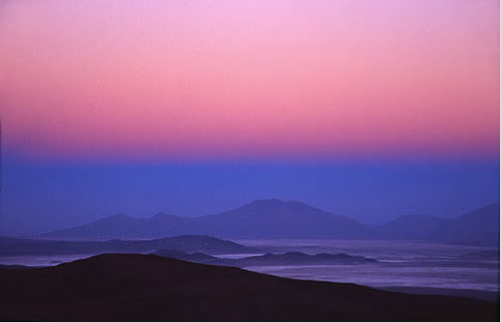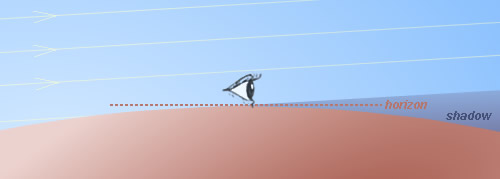Earth Shadow
Earth Shadow: A Phenomenon of Atmospheric Optics
Have you ever noticed a captivating spectacle in the sky after sunset or before sunrise? If you cast your gaze towards the east just after sunset, provided you have a low horizon, you might witness a fascinating natural phenomenon known as the Earth Shadow. This shadow, which rises upwards from the horizon, is the result of the Earth blocking the sun's direct light from reaching the atmosphere. Let's delve deeper into this intriguing atmospheric optics topic and explore the various aspects of the Earth Shadow.
The Earth's Shadow and the Anti-Twilight Arch
As twilight deepens, a dark band gradually emerges from the eastern horizon. This band, aptly named the Earth Shadow, is essentially the shadow cast by our planet onto the atmosphere. It creates a stark contrast against the remaining lit sky. Just above the Earth Shadow, you may notice a beautiful pink band known as the anti-twilight arch or the "Belt of Venus." This rosy glow is formed by scattered sunlight that has been significantly reddened as it interacts with the deep blue hues of the eastern sky.
Observing the Earth Shadow
To witness this captivating phenomenon, look towards the east after sunset. Ensure that your view is unobstructed by a high horizon, such as mountains or buildings. As twilight progresses, you will notice the gradual ascent of the Earth Shadow. Take a moment to appreciate the beauty of nature's artwork painted across the sky. Conversely, if you find yourself awake before sunrise, look westwards to witness the Earth Shadow sinking towards the horizon.
The Nature of the Earth's Shadow
As the sun dips further below the horizon, the Earth's shadow rises in the east. This shadow is essentially a three-dimensional void of unlit atmosphere. The sky located high above this shadowed air remains bright because it is still bathed in sunlight. The light scatters down through the atmosphere, reaching our eyes and creating a stark contrast between the shadowed region and the illuminated sky above.
Understanding the Scale
To comprehend the scale of this phenomenon, it is important to note that the diagram provided is not drawn to scale. The Earth's atmosphere is a relatively thin layer compared to the planet's overall diameter. Therefore, the shadow appears as a band rising upwards from the horizon rather than enveloping the entire sky.
The Science Behind the Earth Shadow
The Earth Shadow is a result of the Earth's spherical shape and its ability to block direct sunlight. When the sun is below the horizon, its rays are unable to reach the atmosphere in certain regions. As a result, these regions remain in darkness, creating the shadow effect. The exact height and shape of the shadow are influenced by various atmospheric conditions, such as the density of particles and the scattering of light.
Other Atmospheric Optics Phenomena
The Earth Shadow is just one example of the captivating atmospheric optics phenomena that can be observed in our skies. Here are a few other noteworthy occurrences:
- Rainbows: A beautiful arc of colors formed by sunlight refracting through water droplets in the air.
- Halos: Circular rings of light encircling the sun or moon, caused by the refraction and reflection of light through ice crystals.
- Sun Pillar: A vertical column of light extending above or below the sun, created by the reflection of sunlight off ice crystals.
- Mirages: Optical illusions caused by the bending of light rays due to variations in air temperature, creating distorted images of distant objects.
Capturing the Earth Shadow
If you're eager to capture the Earth Shadow's mesmerizing beauty, consider taking photographs during twilight hours. Experiment with different exposures and angles to bring out the full magnificence of this atmospheric spectacle. With the right techniques and equipment, you can immortalize this natural phenomenon and share it with others.
Appreciating the Wonders of Nature
The Earth Shadow serves as a reminder of the incredible beauty and complexity of our natural world. By taking a moment to observe and appreciate these atmospheric optics phenomena, we gain a deeper understanding of the intricate workings of our planet and the forces that shape our environment. So, next time you find yourself bathed in the gentle hues of the Earth Shadow, take a moment to reflect on the wonders of the natural world and the awe-inspiring displays it has to offer.
Conclusion
The Earth Shadow is a captivating atmospheric optics phenomenon that occurs after sunset and before sunrise. It is created by the Earth blocking direct sunlight from reaching certain regions of the atmosphere. The resulting shadow rises upwards from the horizon, while above it, the anti-twilight arch or "Belt of Venus" forms, characterized by a beautiful pink glow. Observing and understanding these natural phenomena allows us to appreciate the beauty and complexity of our planet's atmosphere. So, be sure to keep an eye out for the Earth Shadow during your next twilight adventure and marvel at the wonders of nature on display.

After sunset look eastwards. A low horizon is needed but not a volcano. As twilight deepens a dark band rises upwards from the horizon, The band is the shadow of the Earth on the atmosphere. Immediately above, where the evening air is still lit, glows a pink band called the anti-twilight arch or "Belt of Venus". The pink arises from scattered and deeply reddened sunlight mingling with the deep blues of the eastern sky. Look westwards before sunrise to watch the shadow sinking towards the horizon.

The Earth's Shadow. As the sun sinks deeper below the horizon, the Earth's shadow rises in the east. The shadow is a three dimensional void of unlit atmosphere. The sky high above the shadowed air is bright because it is still sunlit and the air scatters light down to the eye. This diagram is not to scale! The atmosphere is a thin skin compared to the diameter of the earth.
Note: this article has been automatically converted from the old site and may not appear as intended. You can find the original article here.
Reference Atmospheric Optics
If you use any of the definitions, information, or data presented on Atmospheric Optics, please copy the link or reference below to properly credit us as the reference source. Thank you!
-
<a href="https://atoptics.co.uk/blog/earth-shadow/">Earth Shadow</a>
-
"Earth Shadow". Atmospheric Optics. Accessed on July 27, 2024. https://atoptics.co.uk/blog/earth-shadow/.
-
"Earth Shadow". Atmospheric Optics, https://atoptics.co.uk/blog/earth-shadow/. Accessed 27 July, 2024
-
Earth Shadow. Atmospheric Optics. Retrieved from https://atoptics.co.uk/blog/earth-shadow/.